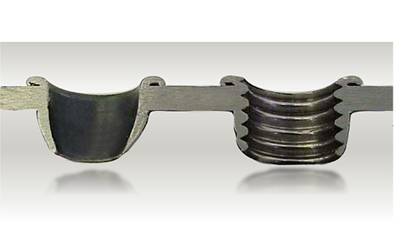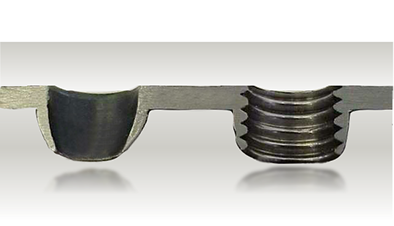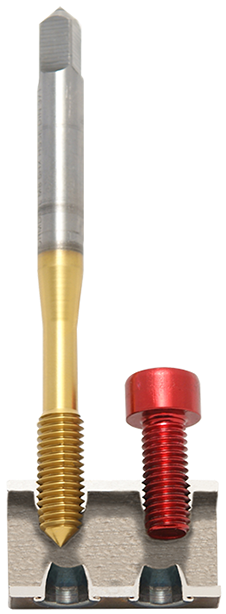
_What is Formdrill?
Formdrill is a thermal drilling process that uses friction heat to produce bushings in metal tubing and flat stock.
The combination of rotational speed and the applied downward force results in friction.
This friction heats up the material and softens it enough to form the hole and displace the material to form the insert.
The length of the bushing is roughly 3 times the original material thickness.
With Formdrill you have the choice between 2 surface finishes: Standard is with a collar/ring on top.
This collar can be also removed in the same operation to end up with a flat surface.


Collar finish
Flat finish
Temperatures can reach 900 °C for the tool and 700 °C for the work piece.
There is absolutely no cutting involved during the creation of the hole.
The Thermal Drilling System can be used in most ferrous and non-ferrous metals including mild steel, stainless steel, copper, brass and aluminium, with material thickness ranging from 1.0mm. up to 12.0mm. (0.040" - 0.500") depending on the diameter of the hole.
No special equipment is required. A standard drill press, milling machine or CNC machining center is suitable. Only requirements are that the machine has the necessary spindle speed, motor power and axial force to push the tool through the material. Example: for M8 this is 2500 RPM and 1.5kW (2.0hp) motor power, for 1/2NPT this is 1200 RPM and 3kW (4.0hp) motor power.
The only items you need to start with Formdrill are a tool holder, a collet, the formdrill tool, formtap tool and lubricants.
Our tool holders have a special heat sink attached for dissipating excess heat generated
by repetitive drilling. The Formdrill tool is clamped in a collet to prevent slipping.
Lubrication is recommended to prolong tool life by reducing material build-up on the tool. Lubricants are available in both paste and liquid form. Lubrication units are available for
use in CNC machines.
Thermal drilling is ideal for automation because it is a chipless process, produces accurate holes, and has a long tool life.
Self-tapping screws can be used to eliminate the tapping operation.
The formed bushings are also used as a through hole for welded, soldered or brazed connections, or for a load bearing surface as in U-Joints.


_What is Formtapping?
Historically, internal threads were created by "cutting" taps. These are tools that are designed to remove material from the
hole leaving a finished internal thread form in the geometry intended. These tools utilize a feature, known as the chamfer,
to achieve a gradual cutting action as the tap enters the hole, and flutes to allow room for the chips created by this
cutting action and coolant or lubricant to assist in the process of cutting and removal of material from the flutes.
Formdrill advises the use of "Formtaps", our objective is to turn as much material as possible into threads.
Cutting away the bushing formed by the Formdrill tool with a cutting tap would lead to a weaker connection.
Formtaps can be applied in materials that cold form well. This includes steels, stainless steels, light metals, light metal alloys and other materials with tensile strength to 1200 N/mm². Generally, materials that produce a continuous chip when drilling are good candidates for thread forming.
Forming taps create thread by displacement of material within the hole.
The formed material assumes the shape of the thread form of the tap without the creation of chips. Some features of the cutting tap like chamfer, are altered to address the forces required to cause the material being threaded to
assume a new form.
Tap Lands separated by flutes are replaced by high areas called lobes.
These lobes are relieved to reduce surface contact with the work material. Friction reduction is a major objective in successfully forming threads.
Thread Cutting
Formtapping
Forming taps require a slightly larger hole, as the material being threaded flows into, as well as away from, the threads of the tap. The finished minor diameter of the hole will be smaller than the unthreaded hole when the process is complete.
It is universally accepted that formed threads are stronger than cut threads and have a smooth, burnished surface finish.
Cold forming taps can also be operated at higher speeds and feeds than conventional taps.
The non-cutting cold working process has an extreme compacting effect on the material, particularly at the root and crest of the thread form and does not fracture the material’s
grain structure.
Thread Cutting
Formtapping
This procedure is particularly suitable with Formdrill for the production of threaded connections. The result is that the structure of the thin-walled bushing is very strongly consolidated and a high quality thread is ensured.
Request
Sample piece_
Cancel
Contact me_
Cancel
Request
Literature_
Cancel

_Info
_Literature
_Sample piece
Click on the "Contact me" button
so we can discuss your application.
Click to receive our literature.
Click on "Sample" button
to get your sample cube.

Sample
Contact me
Literature








